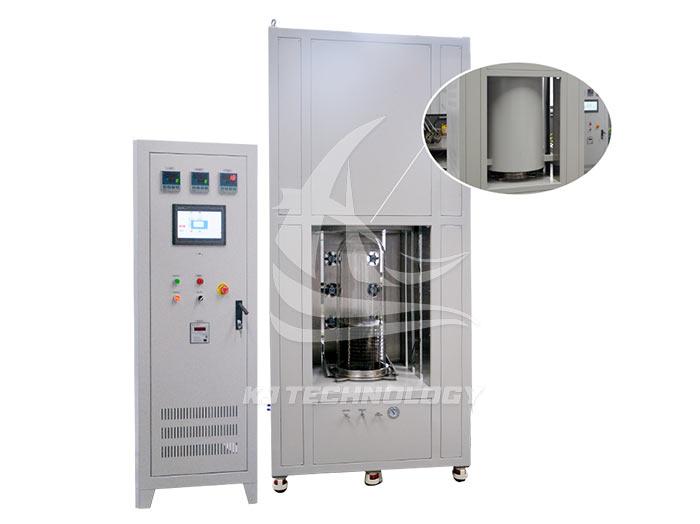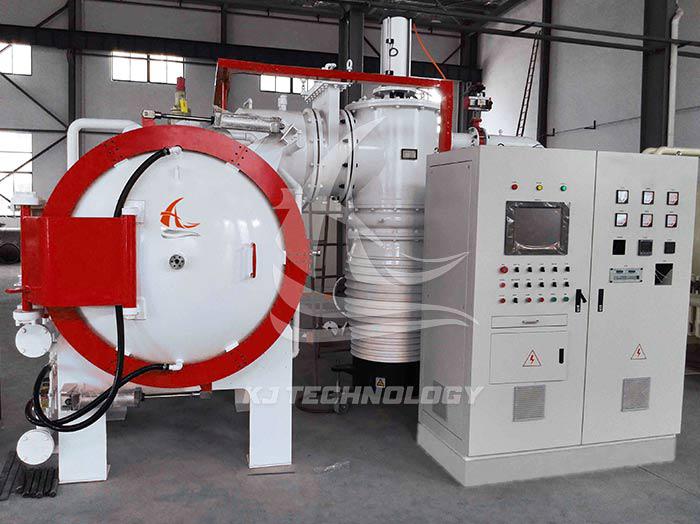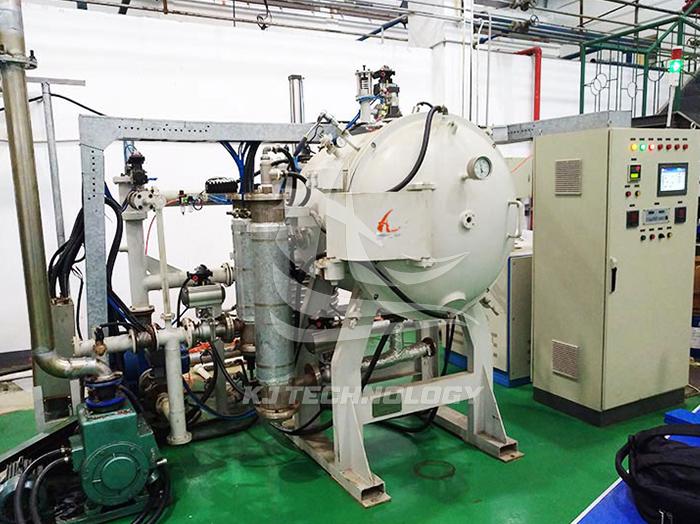Application fields of vertical graphite vacuum furnace
 09-03-2025 Author: KJ technology
09-03-2025 Author: KJ technology
The vertical graphite vacuum furnace has demonstrated irreplaceable application value in multiple high-end manufacturing fields due to its high temperature stability, vacuum environment control capability, and unique properties of graphite materials. The specific application areas are as follows:
1. New Energy Materials: Promoting the Upgrading of Battery and Semiconductor Technologies
Negative electrode material for lithium-ion batteries
In the purification and graphitization process of artificial graphite/natural graphite, a vertical graphite vacuum furnace effectively removes volatile components (such as moisture, residual organic matter) and metal impurities from the material through a high-temperature vacuum environment (usually above 2600 ℃), significantly improving the purity and electrochemical performance of the material. For example, graphitization treatment can increase the capacity of negative electrode materials and prolong their cycle life.
Preparation of Semiconductor Materials
Silicon carbide (SiC) substrate: Under high temperature vacuum (2000 ℃ -2500 ℃), crystal growth and defect repair are achieved by controlling the gas atmosphere (such as argon), improving substrate quality and meeting the demand for high-power devices in fields such as 5G communication and new energy vehicles.
Silicon crystal growth: Using graphite heaters and heat shields, the Czochralski method (CZ method) is used to grow single crystal silicon in vacuum or inert gas, ensuring high crystal purity.
2. Aerospace: Supporting the Manufacturing of High Performance Components
Carbon carbon composite materials
Used for manufacturing key components such as rocket engine nozzles and spacecraft thermal protection systems. The vertical graphite vacuum furnace densifies carbon fiber preforms through high-temperature heat treatment (2200 ℃ -2500 ℃) and chemical vapor infiltration (CVI) process, forming high-strength and low-density carbon carbon composite materials with a specific strength five times that of steel and higher temperature resistance.
High-temperature heating element
Graphite heating elements (such as graphite rods and graphite tubes) can work stably for a long time in a vacuum environment above 2500 ℃. They are used in heating modules of aerospace testing equipment, replacing traditional metal heating elements, significantly reducing energy consumption and extending service life.
3. Powder metallurgy and hard alloys: improving material properties and yield
Hard alloy sintering
Under vacuum or hydrogen atmosphere, a vertical graphite vacuum furnace can achieve low-temperature sintering (1400 ℃ -1500 ℃) of tungsten cobalt (WC Co) hard alloys, avoiding oxidation and promoting liquid-phase sintering, resulting in higher material hardness and improved bending strength.
Rare earth permanent magnet materials
Used for vacuum sintering (1050 ℃ -1100 ℃) and aging treatment of neodymium iron boron (NdFeB) magnets. By precisely controlling the atmosphere and temperature curve, internal stress of the material is eliminated, and the magnetic energy product (BH) max is increased to over 50MGOe, meeting the high-end application needs of new energy vehicle motors, wind turbines, and other applications.
4. Special ceramics and high-temperature alloys: breaking through the limits of traditional materials
high-temperature ceramics
In a vacuum environment, a vertical graphite vacuum furnace can achieve pressureless sintering (1600 ℃ -1800 ℃) of ceramic materials such as silicon nitride (Si ∝ N ₄) and aluminum oxide (Al ₂ O ∝), avoiding oxidation and promoting densification, resulting in high bending strength and improved temperature resistance of the materials.
High temperature alloy melting
By using graphite crucible and induction heating technology, nickel based and cobalt based high-temperature alloys are melted in vacuum or inert gas, effectively removing gas impurities (such as hydrogen and oxygen), improving material purity and high-temperature performance, and meeting the stringent requirements of aviation engine turbine blades and other components.
5. Nuclear Industry and National Defense: Ensuring Autonomous and Controllable Key Materials
Atomic reactor materials
Graphite is used as a neutron moderator and structural material in reactors due to its high melting point (3652 ℃), low neutron absorption cross-section, and good chemical stability. The vertical graphite vacuum furnace can prepare high-purity nuclear grade graphite through high-temperature purification treatment, meeting the extreme material performance requirements of the fourth generation nuclear reactors.
Defense special materials
Silicon carbide fiber-reinforced ceramic matrix composites (CMC) are used to manufacture components such as missile tail fins and infrared windows. Through the hot pressing sintering process (1800 ℃ -2000 ℃) in a vertical graphite vacuum furnace, the material achieves high densification and performance optimization, enhancing the high temperature resistance and impact resistance of weapon systems.
6. Other fields: Expanding application boundaries
Chemical Engineering
After processing in a vacuum furnace, graphite heat exchangers, reaction tanks, and other equipment are widely used in fields such as petrochemicals and hydrometallurgy due to their corrosion resistance and good thermal conductivity. They replace traditional metal equipment, reduce maintenance costs, and extend service life.
Machinery industry
After being manufactured in a vacuum furnace, components such as graphite bearings and sealing rings can work without lubricating oil in the temperature range of 200 ℃ -2000 ℃, significantly reducing the friction coefficient and improving equipment reliability. They are suitable for extreme working conditions such as high speed, high temperature, and high pressure.








